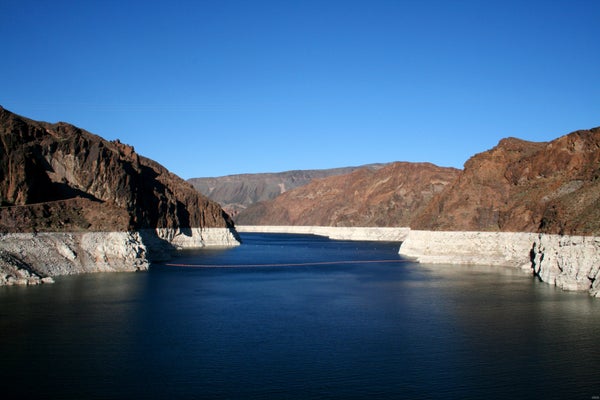The Colorado River system’s ongoing 19-year drought could trigger unprecedented water rationing among its southern states by mid-2020, a new study warns.
The river, which supplies 40 million people, is going through the longest dry spell in recorded history and one of the driest in the past 1,200 years, according to the Bureau of Reclamation.
Over this summer, Reclamation said the chance of a water shortage in the river’s lower basin rose from 52 percent to 57 percent by 2020, based on computer model projections that look ahead five years. The shortages could affect Arizona, California and five other southern states.
On supporting science journalism
If you're enjoying this article, consider supporting our award-winning journalism by subscribing. By purchasing a subscription you are helping to ensure the future of impactful stories about the discoveries and ideas shaping our world today.
The elevation of the most critical reservoir in the area—Lake Mead—could drop by 20 feet or more by mid-2020.
“There is a real sense of urgency across the basin to protect the river’s supply in the face of increasing demand and ongoing drought,” said Reclamation Commissioner Brenda Burman. She said she expects the states to complete a “comprehensive, basinwide drought contingency plan before the end of this year.”
According to the bureau, the lower basin of the river will have enough water to operate in normal conditions through calendar year 2019, but the possibility of water-use restrictions for the following year may be announced by next August.
Other studies have also raised the prospect of future problems with the river’s water supplies.
One, by the Colorado Climate Center, warned that the growing dryness of parts of southwest Colorado and eastern Utah and a low winter snowpack in the mountains “are the perfect ingredients for rapid drawdowns in water supply.”
“Storage is down everywhere, but much better to the north than to the south,” the center reported, noting that some reservoirs were down to 10 percent of their normal storage for late summer.
There is some prospect for relief in the longer term. There are signs that an El Niño is forming in the Pacific Ocean, which usually means cooler, wetter conditions in the southern United States.
But another study, released by the National Center for Atmospheric Research (NCAR), predicted that El Niño and its opposite weather feature—La Niña, which brings warmer, drier temperatures—will present mixed blessings in the future.
As climate change brings steadily warmer temperatures, climate models suggest, the El Niño-La Niña cycles will add an increasingly larger cumulative shock. John Fasullo, an NCAR scientist who headed the study, called it a “weather whiplash” that could occur “particularly in the western U.S.”
Ming Cai, a program officer at the National Science Foundation, which funded the NCAR study, said that by the end of the century, the added impacts of La Niña cycles on top of the growing temperature increases will leave California and other parts of the West “more vulnerable to severe droughts and widespread wildfires in the future.”
According to computer projections, the combination means a La Niña event such as the one that occurred in 2011 could increase the chances of seasonal heat extremes in the southern half of the United States by as much as 30 percent.
Fasullo noted, however, that the study by itself does not predict whether the El Niño or La Niña cycles will continue in the future or, if they do, how big they might be.
“But we can say that an El Niño that forms in the future,” he said, “is likely to have more influence over our weather than if the same El Niño formed today.”
Reprinted from Climatewire with permission from E&E News. E&E provides daily coverage of essential energy and environmental news at www.eenews.net.
